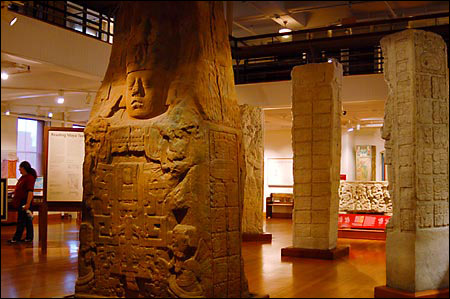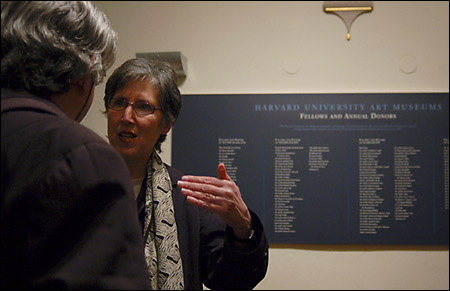Museums find common ground at symposium
Art/art history, anthropology/archaeology closer than some think
In recent years, crossing disciplines is much more common than it used to be, but that doesn’t mean that it’s not a good idea to look both ways before you cross. While ethicists and scientists wrangle about when life begins, and historians and literary scholars buzz about the importance of imperialism in the novels of Jane Austen, there is also a growing relationship between the disciplines of art and art history and those of anthropology and archaeology. A recent symposium recently took a close, fresh look at this relationship.
Those of us who are not art historians or anthropologists may not realize that historically there has been some tension between the two endeavors, as one focuses on aesthetic, the other on cultural, concerns. The symposium, “Crossing Boundaries: Art Museums & Anthropology Museums, in Search of Common Ground,” addressed some of the issues surrounding the great institution these disciplines share – the museum.

“Harvard possesses two powerful collections,” said Thomas Lentz, director of the Harvard University Art Museums, in his keynote speech at the April 21-22 symposium at the Sackler Museum. “But they were assembled at different times, for different purposes, and for the most part according to widely divergent criteria.”
In an interview, William Fash, director of the Peabody Museum of Archaeology and Ethnology, added that though “it used to be that anthropology and art were worlds apart,” scholars working on both sides have been crossing boundaries for decades now. “You’ll find art historians delving deeply into anthropological theory and archaeological reports in order to understand the social context in which great works of art were produced in cultures across the globe. And anthropologists have become acutely aware of the worlds of meaning expressed through material culture, from spoons to Maya steelae. But this is the first time the boundaries are being crossed on an institutional basis at the University.”
After keynote talks Friday night from Lentz, Fash, and Ruth Phillips, the Canada Research chair at Carleton University in Ottawa Saturday’s sessions explored more specific issues museum directors and curators face. They included “Whose Legacy?,” which revisited questions frequently posed in recent newspaper headlines regarding stewardship and the preservation of cultural legacies; and “Art and Anthropology: Challenging Categories,” which addressed the intellectual underpinnings of the two fields in the hope that a common ground would emerge in the forces that shape the creation of all material culture.

A little practical assistance came during the session titled “New Paradigms for Addressing Collections.” In it, Marla Berns, director of the Fowler Museum of Cultural History at the University of California, Los Angeles; Jolene Rickard, an associate professor of art history at the State University of New York, Buffalo, and guest curator at the Smithsonian’s National Museum of the American Indian; and Natalia Majluf, director of the Museo de Arte in Lima, Peru, shared their experiences with the real-world conditions that come into play when mounting an exhibition, discussing, among other things, physical layout, interpretation, and politics – or, as Rickard characterized it, the “polite one-upmanship” involved with questions such as “Whose cultural heritage is most intact? Most beautiful?”
But with eight speakers, including chair Diana Fane, curator emeritus at the Brooklyn Museum of Art, perhaps the most lively and University-relevant session came last: a roundtable called “Shaping the Future of Art and Anthropology Museums at Harvard and Beyond.”

It began with Christopher Brown and Henry Kim of the Ashmolean Museum at the University of Oxford talking about the reorganization currently under way at the Ashmolean that attempts to integrate collections and explore the links among cultures through them. In a break from the standard format to which museum-goers have become accustomed – Greek statuary in a room beside Roman sculptures, Asian art perhaps vaguely associated with African by their placement on the same floor, and so on – the Ashmolean has taken more of a “historical timeline” approach. “What’s happening in Han China during the Roman empire?” Kim asked, showing a slide of a Buddha statue wearing classic Roman draping. “Themes come out if you break away from the geographical bases,” he added. “Cultures aren’t to be segmented. You have to look at them as part of a continuum.”
Harvard College Professor and the James Duncan Phillips Professor of History Laurel Thatcher Ulrich discussed the “places where the margins meet,” noting that museums are “not just for anthropologists and art historians, but for many kinds of scholars,” with Richard Kurin of the Smithsonian adding natural history and science museums to the mix. Kurin also talked about the role of the lay public in the theory and practice of museum curating. “The ethno-aesthetics are converging and exploding,” he said, “in music, fashion, and art throughout the world.” Senior Lecturer Jeffrey Quilter, deputy director of curatorial affairs and curator at the Peabody, took this theme further, linking a renewed interest in objects as history to “the power of ‘Antiques Roadshow.’”
Taken as a whole, the talks seemed to support Lentz’s contention that there is “no compelling reason why these idea worlds cannot to some extent inhabit the same universe.” It has become increasingly obvious, he added, “that [the art museums’] ability to work in closer alignment with the disciplinary concerns and strategies of anthropology and other fields promises new and exciting avenues of research and scholarship.”




